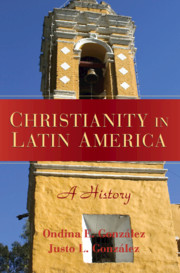Book contents
- Frontmatter
- Contents
- Preface
- Introduction
- 1 Foundations
- 2 The Arrival of Christianity
- 3 The Shaping of the Faith
- 4 Reform Movements
- 5 The Church in Turmoil
- 6 The Church's New Place
- 7 Protestant Immigration
- 8 An Expanding Protestant Presence
- 9 Catholicism after Vatican II
- 10 Pentecostalism and Autochthonous Movements
- 11 By Way of Conclusion
- Some Suggestions for Further Reading
- Sources Referenced
- Index
1 - Foundations
Published online by Cambridge University Press: 05 June 2012
- Frontmatter
- Contents
- Preface
- Introduction
- 1 Foundations
- 2 The Arrival of Christianity
- 3 The Shaping of the Faith
- 4 Reform Movements
- 5 The Church in Turmoil
- 6 The Church's New Place
- 7 Protestant Immigration
- 8 An Expanding Protestant Presence
- 9 Catholicism after Vatican II
- 10 Pentecostalism and Autochthonous Movements
- 11 By Way of Conclusion
- Some Suggestions for Further Reading
- Sources Referenced
- Index
Summary
On Friday, October 12, 1492, Christopher Columbus wrote in his log:
At dawn we saw naked people, and I went ashore in the ship's boat, armed, followed by Martín Alonso Pinzón, captain of the Pinta, and his brother, Vincente Yáñez, captain of the Niña. I unfurled the royal banner and the captains brought the flags which displayed a large green cross with the letters F [Ferdinand] and Y [Isabella] at the left and right side of the cross. Over each letter was the appropriate crown of that Sovereign…. After a prayer of thanksgiving I ordered the captains of the Pinta and Niña, together with Rodrigo de Escobedo (secretary of the fleet), Rodrigo Sánchez of Segovia (comptroller of the fleet) to bear faith and witness that I was taking possession of this island for the King and Queen. I made all the necessary declarations and had these testimonies carefully written down by the secretary…. To this island I gave the name San Salvador, in honor of our Blessed Lord.
Thus began an encounter that would change the world forever. Columbus's assumptions that he could lay claim to the lands he encountered by simply unfurling some flags, making some declarations, and offering prayers may seem strange to us today. But this attitude reflected deeply held European views on how the world was ordered, the place of Europe in the world, and its responsibility to Christianize all whom it encountered.
- Type
- Chapter
- Information
- Christianity in Latin AmericaA History, pp. 12 - 39Publisher: Cambridge University PressPrint publication year: 2007

